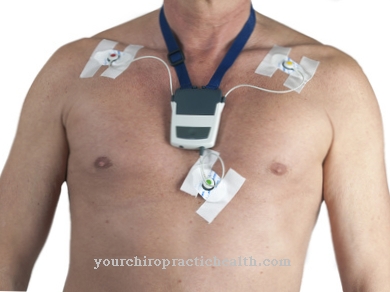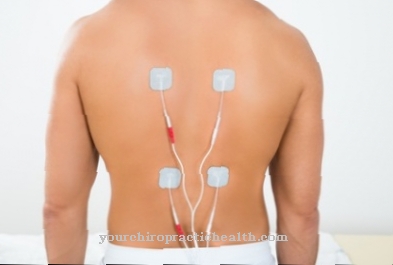A Bone density measurement is used to assess the risk of osteoporosis and bone fractures. Different measuring methods enable an assessment of bone strength and structure by determining the calcium salt content in the examined bone.
What is a bone density measurement?

Using a Bone density measurement (osteodensitometry) the stability and quality of the examined bones is determined indirectly via the calcium hydroxylapatite content.
Different methods are available for measuring bone density, which differ in terms of their significance. In all methods of bone density measurement, rays penetrating the bone (including X-rays, ultrasound) are used, whereby the respective radiation exposure is below that of a chest X-ray (X-ray examination of the chest).
Bone density measurements are usually carried out in the case of osteoporosis or if osteoporosis is suspected for early detection and follow-up, since the relationship between the calcium salt content and the bone matrix is reduced in osteoporosis. In the case of certain diseases of the gastrointestinal tract (including Crohn's disease, malabsorption), long-term use of cortisone, hyperthyroidism (overactive thyroid) and in organ transplant people, regular bone density measurements are also recommended due to the increased risk of osteoporosis.
Function, effect, application & goals
The Bone density measurement It is primarily used for the (early) detection of osteoporosis (progressive reduction in bone substance) and osteopenia, which is characterized by a bone density that is lower than the age-specific standard value and is an optional preliminary stage of osteoporosis. The course of the disease in the case of osteoporosis can also be checked as part of regular bone density determinations. With the help of a bone density measurement, the individual risk of bone fractures can also be determined. In all available measurement methods, rays are used that are absorbed differently depending on the specific bone density or the mineral salt content.
The extent of radiation absorption by the mineral salts in the bones allows statements to be made about bone density by determining the deviation from an age-specific standard value. A reliable and most frequently used method for assessing the long-term success of osteoporosis therapy is the so-called DXA or DEXA (Dual Energy X-Ray Absorptiometry or Double Energy X-Ray Absorptiometry). Two images are taken with energetic various X-ray sources so that the proportion of soft tissue (fat, muscle, connective tissue) in the X-ray absorption can be determined and deducted accordingly.
As a rule, the measurement is carried out on the hip joint or on the lumbar spine because the most meaningful results can be expected there. The area-projected mass (two-dimensional surface density) determined as part of the DXA is used in particular to assess the risk of bone fractures near the hip (including femoral neck fractures) and vertebral body fractures (including the lumbar spine). In addition, the bone density can be determined by quantitative computed tomography (QCT). The procedure is a special form of computed tomography in which three-dimensional X-ray slices of the lumbar spine are carried out.
This ensures a differentiation between the bone density of the outer bone layer (cortex) on the one hand and the trabecular trabeculae on the other. Since the metabolic activity is higher in the trabeculae than in the outer layer of the bone, the method allows statements to be made about changes in bone metabolism. This in turn enables an assessment of the risk of fractures as well as the rate of progression with which the bone substance regresses in osteoporosis. With peripheral quantitative computed tomography (pQCT), bone density is not measured on the lumbar spine, but on the forearm.
In contrast to DXA, the composition of bone, muscle and fat tissue can only be determined locally with a qualitative computer tomography. Another method for determining the density of peripheral bones is qualitative ultrasound (QUS). Here, the bone to be examined is sonographically treated. The sound absorption and the speed with which the sound passes through the bones allow conclusions to be drawn about the properties of the bones. Since the bone density in the axial skeleton has not yet been able to be determined using this osteodensitometry method, its use for the diagnosis and follow-up of osteoporosis is currently unsuitable.
Risks, side effects & dangers
With the exception of the qualitative ultrasound, all methods for measuring bone density are associated with the use of X-rays and, depending on the method used, with a different radiation exposure for the human organism.
The radiation exposure of a DXA is around one to six µSv, which is many times less than the annual average exposure to earth radiation of around two mSv (1 mSv = 1000 µSv). With one to five mSv, the qualitative computed tomography correlates with a comparatively high radiation exposure. From 100 mSv per year, there is a statistically demonstrable increased risk of cancer.
On its own, a routine x-ray examination is generally low-risk, but frequent and unnecessary x-rays should be avoided. If you are pregnant, a Bone density measurement Contraindicated with X-rays, since even low radiation exposure can affect the genesis of the unborn child.
Typical & common bone diseases
- osteoporosis
- Bone pain
- Broken bone
- Paget's disease













.jpg)

.jpg)
.jpg)











.jpg)